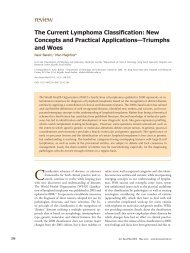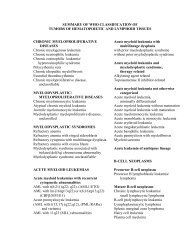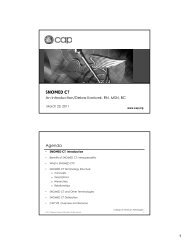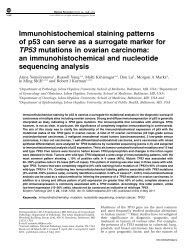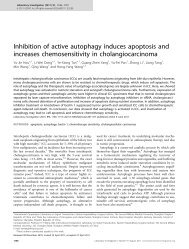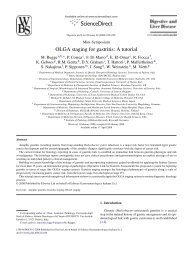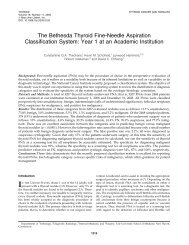SUBTYPES OF OVARIAN CARCINOMA 423Postulated development <strong>of</strong> low-grade and high-grade<strong>ovarian</strong> serous <strong>carcinoma</strong>Fimbria <strong>of</strong> fallopian tubeOvarian surface epitheliumBenign serous cystadenomaSerous tubalintraepithelial<strong>carcinoma</strong> (serousTIC)OvarianintraepithelialneoplasiaCorticalinclusioncystsUsual serous borderlineneoplasmMicropapillary variant <strong>of</strong> serousborderline neoplasmHigh gradeserous <strong>carcinoma</strong>Low gradeserous <strong>carcinoma</strong>Fig. 2Postulated developmental pathways <strong>of</strong> low grade and high grade serous <strong>carcinoma</strong>.including nested, papillary (micropapillary or macropapillary),glandular (slit-like or round spaces), cribriform, solid and singlecells. The glands and papillae in low grade serous <strong>carcinoma</strong>sare <strong>of</strong>ten surrounded by clefts or non-epithelial lined spaces andintracytoplasmic mucin is <strong>of</strong>ten a feature. 39 Psammoma bodiesare common in both tumour types. Psammo<strong>carcinoma</strong> is a termused for a tumour with extensive psammoma body formationand is usually morphologically a low grade serous <strong>carcinoma</strong>,although occasional examples have high grade nuclear cytology,in keeping with high grade serous <strong>carcinoma</strong>.Both low grade and high grade serous <strong>carcinoma</strong>s typicallyexpress WT1. High grade serous <strong>carcinoma</strong> exhibits significantlygreater expression <strong>of</strong> p53, MIB1, bcl-2, c-kit, Her-2 neu,HLA-G and p16 than low grade serous <strong>carcinoma</strong>. 40,41 p16 istypically diffusely positive in high grade serous <strong>carcinoma</strong> andfocally positive or negative in low grade. Low grade serous<strong>carcinoma</strong>s are almost always diffusely positive with oestrogenreceptor (ER), as are a high percentage <strong>of</strong> high grade serous<strong>carcinoma</strong>s (70–80%). High grade serous <strong>carcinoma</strong>s mostcommonly exhibit diffuse intense nuclear immunoreactivitywith p53 but totally absent staining (‘all or nothing’) is also anaberrant pattern <strong>of</strong> p53 staining and suggestive <strong>of</strong> an underlyingTP53 abnormality (see next section). So-called ‘wild-type’ p53staining, with a focal, weak and heterogenous pattern, is notindicative <strong>of</strong> a TP53 abnormality and is characteristic <strong>of</strong> lowgrade serous <strong>carcinoma</strong>. 42Molecular events in low grade and high grade serous<strong>carcinoma</strong>The underlying molecular events differ between low grade andhigh grade serous <strong>carcinoma</strong>. Low grade serous <strong>carcinoma</strong> isassociated with k-ras or b-raf mutation in approximately twothirds<strong>of</strong> cases. 21–27 These mutations occur early in the evolution<strong>of</strong> low grade serous <strong>carcinoma</strong> since they are also found inborderline and benign areas within the same neoplasm. K-rasand b-raf mutations appear mutually exclusive; in other wordsone, but not both, may be present in a particular neoplasm. TheERBB2 gene is also frequently mutated. 27 Low grade serous<strong>carcinoma</strong> is not associated with TP53 mutations. 21–27 Incontrast, high grade serous <strong>carcinoma</strong>s harbour, in most cases,a TP53 mutation or exhibit p53 dysfunction and this appears tooccur early in neoplastic development; 20–26 they are not, exceptin occasional cases, associated with k-ras, b-raf or ERBB2mutation. A recent study using stringent techniques identifiedTP53 mutations in 97% <strong>of</strong> <strong>ovarian</strong> high grade serous <strong>carcinoma</strong>s;most <strong>of</strong> the mutation negative cases exhibited TP53Fig. 3 (A) Low grade serous <strong>carcinoma</strong> with a micropapillary architecture and clefts surrounding the groups <strong>of</strong> tumour cells. (B) On high power <strong>of</strong> another low gradeserous <strong>carcinoma</strong>, the tumour cells are bland with little mitotic activity.Copyright © Royal College <strong>of</strong> pathologists <strong>of</strong> Australasia. Unauthorized reproduction <strong>of</strong> this article is prohibited.
424 MCCLUGGAGE <strong>Pathology</strong> (2011), 43(5), Augustserous <strong>carcinoma</strong> was 9% with a median survival <strong>of</strong> 1.7 years 36while low grade serous <strong>carcinoma</strong>s had a median survival <strong>of</strong>4.2 years and a 5 year survival <strong>of</strong> 40%. 36 In another study <strong>of</strong> lowgrade serous <strong>carcinoma</strong>s, the median overall survival with stageIII or IV disease was 6.8 years. 44 Low grade serous <strong>carcinoma</strong>s<strong>of</strong>ten prove fatal but in some cases the course is indolent and ina few cases the patient survives for a considerable period <strong>of</strong>time, for example in excess <strong>of</strong> 10 or 20 years.Fig. 4 High grade serous <strong>carcinoma</strong> with slit-like spaces and abundant mitoticactivity.dysfunction, illustrating that p53 is abnormal in almost 100% <strong>of</strong>high grade serous <strong>carcinoma</strong>s. 43 High grade serous <strong>carcinoma</strong>sare also associated with BRCA1 and BRCA2 abnormalities,including germline mutations and somatic abnormalities.Behaviour <strong>of</strong> low grade and high grade serous <strong>carcinoma</strong>Most low grade and high grade serous <strong>carcinoma</strong>s are stage IIIor IV when diagnosed. At present, management is similarbetween these two tumour types and consists, in most cases,<strong>of</strong> total surgical debulking if possible followed by adjuvantchemotherapy. In cases where surgical debulking is not consideredfeasible, upfront chemotherapy may be the method <strong>of</strong>treatment and this may or may not be followed by surgicaldebulking. However, adjuvant chemotherapy is usually notadministered for a stage I low grade serous <strong>carcinoma</strong>.Additionally, there is a growing realisation amongst oncologiststhat low grade serous <strong>carcinoma</strong>s do not respond well totraditional chemotherapeutic agents and if the tumour is optimallydebulked with no gross residual disease, some oncologistsdo not administer adjuvant chemotherapy. High gradeserous <strong>carcinoma</strong> is an aggressive neoplasm which usuallyresponds well initially to chemotherapy but which commonlyrecurs. Few studies have directly compared the outcomebetween low grade and high grade serous <strong>carcinoma</strong>. In onestudy, the survival <strong>of</strong> patients with low grade neoplasms wassignificantly better than that <strong>of</strong> patients with high gradetumours. 36 In this study, the 5 year survival for high gradeEVIDENCE FOR ORIGIN OF HIGH GRADEPELVIC SEROUS CARCINOMA FROM DISTALFALLOPIAN TUBEThere is recent convincing and accumulating evidence thatmany currently classified high grade serous <strong>carcinoma</strong>s <strong>of</strong> theovary, fallopian tube and peritoneum (collectively referred to ashigh grade pelvic serous <strong>carcinoma</strong>) are derived from thefimbria <strong>of</strong> the fallopian tube. 30–35 Most <strong>of</strong> the work hasemanated from Christopher Crum and colleagues in the Brighamand Women’s Hospital, Boston, USA. The initial evidencefor this came from prophylactic salpingo-oophorectomy specimensin patients with germline BRCA1 or BRCA2 mutation,these patients having a high risk <strong>of</strong> developing <strong>ovarian</strong> highgrade serous <strong>carcinoma</strong>. In initial studies, small high gradeserous <strong>carcinoma</strong>s were occasionally identified in the ovary butthis was rare. However, when pathologists began examining thefallopian tubes in their entirety, it was found that there wasmore likely to be a small in situ or invasive high grade serous<strong>carcinoma</strong> involving the mucosa <strong>of</strong> the fimbria <strong>of</strong> the fallopiantube; the in situ lesions are referred to as serous tubal intraepithelial<strong>carcinoma</strong> (serous TIC). This is relatively uncommonbut is occasionally seen in prophylactic salpingo-oophorectomyspecimens in patients with BRCA1 or BRCA2 germlinemutation. Further studies systematically examined the fallopiantubes in patients with sporadic high grade <strong>ovarian</strong> serous<strong>carcinoma</strong> and found similar lesions involving the fimbria ina significant percentage <strong>of</strong> cases (Fig. 5). 30,33 Furthermore,identical TP53 mutations were demonstrated within the <strong>ovarian</strong>and tubal lesions. While this does not unequivocally prove thatthe origin is within the fallopian tube (this could represent atumour originating within the ovary and spreading to thefallopian tube), there is accumulating evidence that many highgrade pelvic serous <strong>carcinoma</strong>s arise from the tubal fimbriafrom serous TIC. A p53 signature has also been demonstrated inthe fallopian tube. 45 This takes the form <strong>of</strong> small foci <strong>of</strong> intensep53 nuclear staining involving consecutive secretory cells,most commonly <strong>of</strong> the fimbria, in the absence <strong>of</strong> morphologicalFig. 5 (A) Serous tubal intraepithelial <strong>carcinoma</strong> (serous TIC) involving fimbria <strong>of</strong> fallopian tube and exhibiting diffuse nuclear p53 positivity; (B) the adjacent tubalepithelium is p53 negative.Copyright © Royal College <strong>of</strong> pathologists <strong>of</strong> Australasia. Unauthorized reproduction <strong>of</strong> this article is prohibited.




